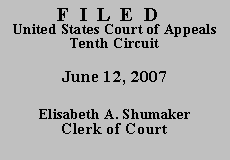

| JOHN GLENN SNYDER, |
|
| v. | |
| JOE ORTIZ, and JOHN W. SUTHERS, Attorney General of the State of Colorado, |
Snyder is challenging the validity of his August 5, 2002 state court conviction for sexual assault on a child by a person in a position of trust. While Snyder did not file a direct appeal, he sought post-conviction relief in state court. Before the district court, Snyder alleged these post-conviction proceedings were pending from December 27, 2002 until October 17, 2005, when the Colorado Supreme Court denied his petition for certiorari. The district court received Snyder's petition for habeas corpus on July 26, 2006.
Based on the preceding dates, the district court denied Snyder's petition as untimely under the applicable one-year statute of limitations provided by 28 U.S.C. § 2244(d):
(1) A 1-year period of limitation shall apply to an application for a writ of habeas corpus by a person in custody pursuant to the judgment of a State court. The limitation period shall run from the latest of--
(A) the date on which the judgment became final by the conclusion of direct review or the expiration of the time for seeking such review;
* * *
(2) The time during which a properly filed application for State post-conviction or other collateral review with respect to the pertinent judgment or claim is pending shall not be counted toward any period of limitation under this subsection.
In light of the foregoing, the district court found the one-year limitations period began to run on September 19, 2002, when the time for filing a direct appeal in Snyder's case (45 days after his August 5 conviction) had expired and his conviction became final. See § 2244(d)(1)(A). Moreover, and pursuant to § 2244(d)(2), the district court properly tolled the statute of limitations during the pendency of Snyder's post-conviction proceedings--which Snyder had claimed ran from December 27, 2002 to October 17, 2005.
Thus, between the date Snyder's conviction became final (September 19, 2002) and the initiation of his post-conviction proceedings (December 27, 2002), a total of 98-days had elapsed. At that point, the statute of limitations was tolled until the conclusion of Snyder's post-conviction case on October 17, 2005. The clock then began ticking anew and expired 267 days later (98 days + 267 days = 365 days, or one year) on July 12, 2005. However, the district court did not receive Snyder's habeas petition until July 26, 14 days after the statute of limitations had allegedly expired.
On appeal, however, Snyder argues that his post-conviction proceedings actually commenced on December 2, 2002 rather than on December 27, 2002, as he originally represented to the district court. As a result, he claims the statute of limitations should be tolled 25 days earlier than the date the district court had calculated. In fact, the Colorado state court docket sheet reflects that Snyder's first post-conviction filing was made on December 2, 2002 rather than on December 27, 2002. Thus, if added to the 281 days that elapsed between the end of Snyder's post-conviction proceedings and the instant petition for habeas corpus, the result would be that Snyder's petition was filed on the 354th day of the one-year limitations period and was, therefore, timely.
In its response, the government concedes that Snyder's computation is correct, and that his habeas petition had been timely filed in the district court.(1) Therefore, we REVERSE and REMAND for proceedings consistent with this order and judgment. Additionally, we note appellant has filed a motion for the appointment of counsel. We refer that motion to the district court for consideration on remand. See 18 U.S.C. § 3006A(a)(2)(B)(noting court may
appoint counsel in habeas matters proceeding under § 2254 if the interests of justice so require).
Entered for the Court ,
Timothy M. Tymkovich
Circuit Judge
*. This order and judgment is not binding precedent except under the doctrines of law of the case, res judicata and collateral estoppel. It may be cited, however, for its persuasive value consistent with Fed. R. App. P. 32.1 and 10th Cir. R. 32.1.
2. After examining the briefs and the appellate record, this three-judge panel has determined unanimously that oral argument would not be of material assistance in the determination of this appeal. See Fed. R. App. P. 34(a); 10th Cir. R. 34.1(G). The cause is therefore ordered submitted without oral argument.
1. The government does not argue any waiver or estoppel theories on appeal.